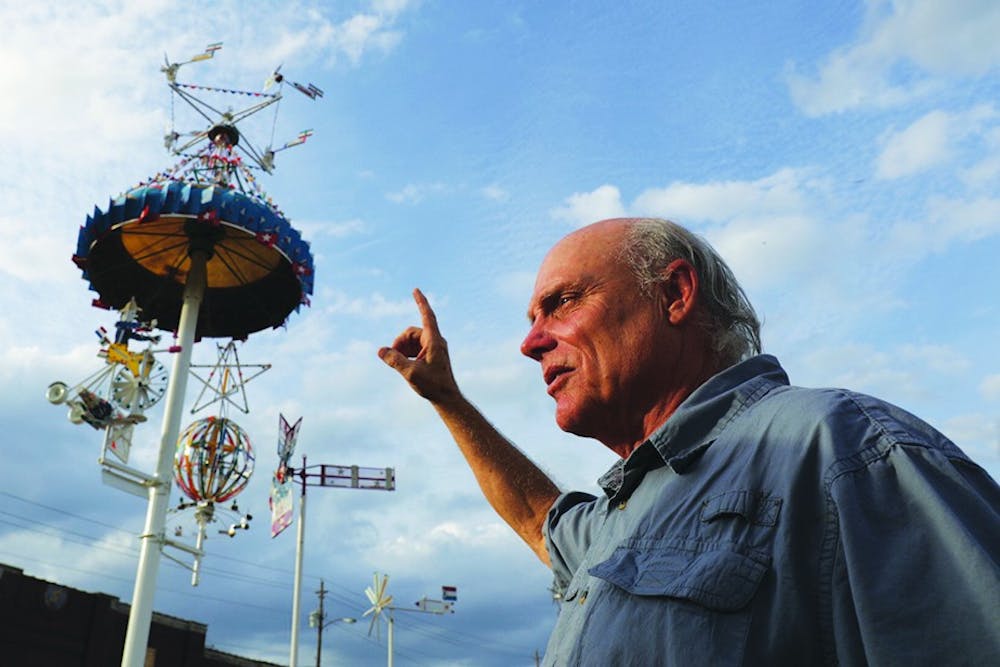“A lot of people will drink beer down there and wait for the sun to get low, and they just sit there and watch,” he said.
The art’s onlookers sit at 217 Brew Works, which opened in November. It’s on a block facing the park among three buildings also owned by the brewery’s owner, Tom Curran, and his wife, Barbara Conklin. They wanted to invest in the area around the park to draw in locals and visitors.
Since the start of the project, about $25 million in private and public development has sprung up within a two block radius of the park. Curran said Hi-Dollar, an old tobacco warehouse next to the park, is being renovated into about 90 apartments, four retail shops and a restaurant. The project costs about $12 million, and the building will be called the Whirligig Station.
“If that park were not here, we would not be here,” Curran said. “If that park were not here, I don’t know that other developments in downtown would be happening as quickly as they are now.”
Quantifiable economic returns
The Trump administration has proposed cutting funding for the NEA entirely in its proposed 2018 budget. Founded in 1965, the NEA is a federal agency that funds the arts in all 50 states.
The NEA gave grants totaling $1,712,800 to projects and organizations in North Carolina in 2016.
Wayne Martin, director of the N.C. Arts Council, said that the NEA funds about 10 percent of the N.C. Arts Council’s budget, while the state funds 80 percent and private donations fund 10 percent. He said that eliminating the NEA would have an impact on how the arts are funded.
“It would require a whole rethinking of the model on which this is based,” Martin said. “When the endowment was created and all the state art agencies were created, the non-profit model was used as the way that resources would be distributed to create development in the arts.”
Martin said that besides the personal significance that art brings to individuals, it also has an economic impact.
“On what I call a public value level, there are all the ways that the arts are used in education, to help students succeed,” Martin said. “Or in downtown revitalization, to assist communities in becoming places that people want to live and work, and in economic development, which is about attracting businesses and people to North Carolina because they want to live here.”
Daniel Mayer, director of The Arts Center of Carrboro, said he agreed that the arts are good for a local economy.
To get the day's news and headlines in your inbox each morning, sign up for our email newsletters.
“If you spend money on the arts center, people come here, people buy meals, people buy gas, people spend the night at a hotel, people go to a bar after the show,” Mayer said. “And if you spend money in the schools, test scores are higher, dropout rates are lower — there are all kinds of ways in which the arts are a multiplier for economic development and prosperity.”
Data from the NEA backs up Mayer’s claims. A report on the NEA’s website says each dollar the federal government spends directly through the NEA results in up to $9 in private and public funds.
Martin pointed to North Carolina’s flourishing tourism industry as another way that the arts attract business and investment to the state.
“We really have forged the way as far as taking North Carolina’s oldest arts traditions and organizing those and combining them in ways that attract people to the state that result in millions of dollars in economic impact,” Martin said.
The NEA was allotted 0.004 percent of the federal budget in 2016.
“Given the very tiny amounts of funding that are put in, and then the results from that tiny amount of funding, if you looked at it as an investment, it’s a no-brainer,” Martin said.
Arts for everyone
Advocates for the NEA point to the agency’s dedication to supporting the arts throughout the country, not just in urban or affluent areas.
“Funding for the arts through government sources is important because it enables a more level playing field for everyone to be able to experience the arts,” Mayer said.
The NEA’s website says that 40 percent of NEA-supported activities take place in high-poverty neighborhoods, and 36 percent of NEA grants go to organizations that use the arts to help populations such as people with disabilities and veterans.
Martin said arts programs funded by the NEA that support veterans might not exist without public funds.
“It results in assistance for wounded warriors who are coming back with traumatic head injuries and PTSD, and the arts are helping them heal,” he said. “The private sector is not going to do that.”
Martin also said that the N.C. Arts Council gives funding for projects in all 100 counties in the state.
“When we’re working with downtowns in small towns to help revitalize their downtown and rebrand themselves, they don’t have the resources to hire a big firm to come in and do that,” he said. “We help them because that’s our mission and we have public funds to do that. Otherwise, how are you going to help Wilson get a Whirligig Park?”
state@dailytarheel.com




